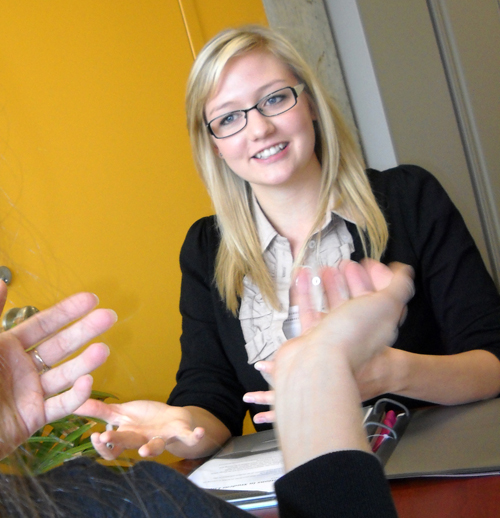
She’d sailed through high school in Barrie, Ont., with an A average and had begun her bachelor of science with an entrance scholarship at U of G. That’s when things fell apart. Living off campus that fall, Sara-Marie Skovbjerg found herself disconnected from the campus and her peers.
“It was difficult for me to transition into university, which, sadly, reflected in my grades,” she says. By the end of the first semester, her overall mark had fallen to about 55 per cent and she’d even failed chemistry. “All of a sudden, everything blew up in my face.”
She was considering a different program and even leaving the University entirely. “I didn’t know where I was supposed to be.” Then someone mentioned Bounce Back, a fledgling program at U of G’s Centre for New Students (CNS) designed to help struggling first-years.
Now completing her psychology program, Skovbjerg is carrying an 80-per-cent average toward graduation this spring. She’s applied to grad school to study social work and is thinking about a career in counselling.
Bounce Back started in 2006 as a voluntary program to help first-year students focus on their academic and learning problems and find resources to correct them, says Monica Munaretto, co-ordinator of new student advising in Student Life. She runs the program along with Naeem Ordonez, co-ordinator of mentoring programs.
The program is funded by the Ministry of Training, Colleges and Universities and by student services fees. It’s offered in the winter semester to students with an average below 60 per cent in their first semester. Under the program, first-year students meet with senior undergrads or grad students who are trained and paid as facilitators by CNS.
By mid-January, about 250 first-year students had enrolled in the program; about 400 students in total are expected to take part this semester. Typically, participants meet weekly with their facilitators. Some may enrol for only two or three weeks, others for much of the semester.
“It’s helping students to be successful, to feel confident in their abilities, to learn about and access resources, and ultimately to improve retention rates,” says CNS manager Barry Townshend. He says the program is among various initiatives offered to help students adjust to university, including START Online and Orientation Week.
Studies show it’s not uncommon for new students to see their grades drop by 10 to 15 per cent from high school. During regular meetings with their Bounce Back facilitator, first-years discuss problems and look for resources to get back on track. Says Ordonez: “These are successful people who got into university. They have the know-how. Something didn’t go quite right, and we’re trying to discover where that lies.”
The remedy might include arranging a tutor for a specific course. More often, it’s a general learning skills problem: time management, essay and exam preparations, stress, writing skills, perhaps a disability of some kind. Referring to the National Survey on Student Engagement, Munaretto says grades may fall if students feel disconnected from the campus, classmates or program ─ a problem that can feed on itself.
Eligible students automatically receive an e-mail about the program from CNS. But that’s only the first trigger. Recognizing that disengaged students are probably checking e-mail less regularly, CNS advertises the program in materials handed out in classes and promotes it through residence life staff, the CNS Off Campus Connection program, academic advisers and other services. “If they’re not networked, they’re not getting these resources,” says Ordonez.
Bounce Back employs 35 facilitators who work for five or 10 hours per week. Most of that time is spent in meeting or talking with students and helping participants connect with learning resources across campus.
“The vast majority of participants will see a substantial increase in grades, and results from previous cycles have shown an extra three- to seven-per-cent increase over GPA improvements for non-participants,” says Munaretto.
The most improved Bounce Back students are eligible for a $1,000 tuition credit for the next year.
Most participants are happy with the program, according to CNS survey results. Says Munaretto: “They realize the University cares. Not only does the University care, but it has put measures in place. There’s a sense of helping.”
That’s echoed by former participant Skovbjerg. She says her turning point that first winter came when her Bounce Back faciltator pointed her to the Library Learning Commons. There she attended sessions on time and stress management, study habits and writing skills. Because of back problems, she sought accommodations with the Centre for Students with Disabilities; she has written her tests in the CSD exam centre.
Skovbjerg also worked with academic counsellors to switch to a BA by her second year, funded partly by earning that $1,000 tuition credit. “I was very happy about that. It boosted my self-esteem. I thought, ‘I can do this.’”
In 2008, she served as a Bounce Back facilitator. This year she’s a facilitator with the Off Campus Connection program and helps other students in the CSD exam centre.